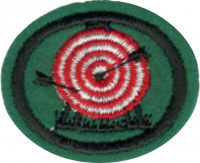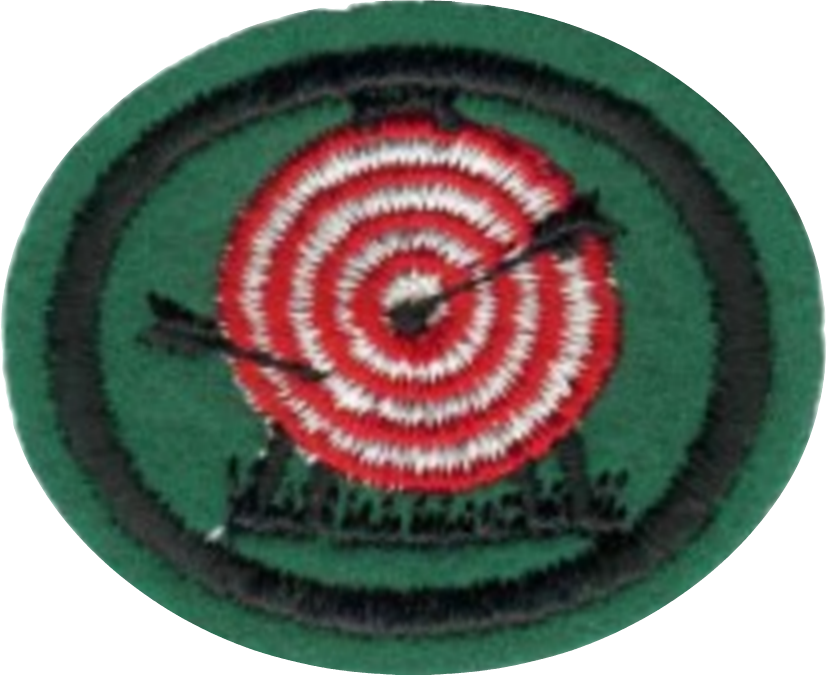Difference between revisions of "AY Honors/Archery/Answer Key 2/es"
From Pathfinder Wiki
(Created page with "</noinclude> <!-- 6. Demostrar las siguientes técnicas de disparo: --> <noinclude>") |
(Updating to match new version of source page) |
||
| (29 intermediate revisions by 2 users not shown) | |||
| Line 1: | Line 1: | ||
| − | + | {{HonorSubpage}} | |
| − | + | {{#vardefine:reqpage|{{#titleparts:{{PAGENAME}}|2}}/Requirements 2}} | |
| − | |||
| − | {{ | ||
| − | |||
| − | |||
| − | |||
| − | |||
| − | |||
| − | |||
| − | |||
| − | }} | ||
| − | |||
| − | {{ | ||
| − | |||
| − | |||
| − | |||
| − | < | + | <!--{{Honor_Master|honor=Archery|master=Sportsman}}--> |
| − | + | {{ansreq|page={{#var:reqpage}}|num=1}} | |
| − | {{ansreq|page={{# | ||
<noinclude></noinclude> | <noinclude></noinclude> | ||
<!-- 1. Identificar las partes de un arco. --> | <!-- 1. Identificar las partes de un arco. --> | ||
| Line 27: | Line 11: | ||
<noinclude></noinclude> | <noinclude></noinclude> | ||
{{CloseReq}} <!-- 1 --> | {{CloseReq}} <!-- 1 --> | ||
| − | {{ansreq|page={{# | + | {{ansreq|page={{#var:reqpage}}|num=2}} |
<noinclude></noinclude> | <noinclude></noinclude> | ||
<!-- 2. Identificar las partes de una flecha. --> | <!-- 2. Identificar las partes de una flecha. --> | ||
| − | |||
{{clear}} | {{clear}} | ||
| Line 36: | Line 19: | ||
<noinclude></noinclude> | <noinclude></noinclude> | ||
{{CloseReq}} <!-- 2 --> | {{CloseReq}} <!-- 2 --> | ||
| − | {{ansreq|page={{# | + | {{ansreq|page={{#var:reqpage}}|num=3}} |
<noinclude></noinclude> | <noinclude></noinclude> | ||
<!-- 3. Nombrar y explicar las normas de seguridad para el tiro con arco. --> | <!-- 3. Nombrar y explicar las normas de seguridad para el tiro con arco. --> | ||
| Line 42: | Line 25: | ||
<noinclude></noinclude> | <noinclude></noinclude> | ||
{{CloseReq}} <!-- 3 --> | {{CloseReq}} <!-- 3 --> | ||
| − | {{ansreq|page={{# | + | {{ansreq|page={{#var:reqpage}}|num=4}} |
<noinclude></noinclude> | <noinclude></noinclude> | ||
<!-- 4. De manera correcta y segura, colocar la cuerda al arco. --> | <!-- 4. De manera correcta y segura, colocar la cuerda al arco. --> | ||
| Line 60: | Line 43: | ||
<noinclude></noinclude> | <noinclude></noinclude> | ||
{{CloseReq}} <!-- 4 --> | {{CloseReq}} <!-- 4 --> | ||
| − | {{ansreq|page={{# | + | {{ansreq|page={{#var:reqpage}}|num=5}} |
<noinclude></noinclude> | <noinclude></noinclude> | ||
<!-- 5. Describir y demostrar cómo usar lo siguiente: --> | <!-- 5. Describir y demostrar cómo usar lo siguiente: --> | ||
<noinclude></noinclude> | <noinclude></noinclude> | ||
| − | {{ansreq|page={{# | + | {{ansreq|page={{#var:reqpage}}|num=5a}} |
<noinclude></noinclude> | <noinclude></noinclude> | ||
<noinclude></noinclude> | <noinclude></noinclude> | ||
{{CloseReq}} <!-- 5a --> | {{CloseReq}} <!-- 5a --> | ||
| − | {{ansreq|page={{# | + | {{ansreq|page={{#var:reqpage}}|num=5b}} <!--T:15--> |
| − | <noinclude></noinclude> | + | <noinclude></noinclude> |
{{clear}} | {{clear}} | ||
| Line 78: | Line 61: | ||
<noinclude></noinclude> | <noinclude></noinclude> | ||
{{CloseReq}} <!-- 5b --> | {{CloseReq}} <!-- 5b --> | ||
| − | {{ansreq|page={{# | + | {{ansreq|page={{#var:reqpage}}|num=5c}} <!--T:18--> |
<noinclude></noinclude> | <noinclude></noinclude> | ||
<noinclude></noinclude> | <noinclude></noinclude> | ||
{{CloseReq}} <!-- 5c --> | {{CloseReq}} <!-- 5c --> | ||
| − | {{ansreq|page={{# | + | {{ansreq|page={{#var:reqpage}}|num=5d}} <!--T:19--> |
<noinclude></noinclude> | <noinclude></noinclude> | ||
| Line 92: | Line 75: | ||
<noinclude></noinclude> | <noinclude></noinclude> | ||
{{CloseReq}} <!-- 5d --> | {{CloseReq}} <!-- 5d --> | ||
| − | {{ansreq|page={{# | + | {{ansreq|page={{#var:reqpage}}|num=5e}} <!--T:22--> |
<noinclude></noinclude> | <noinclude></noinclude> | ||
| Line 100: | Line 83: | ||
{{CloseReq}} <!-- 5e --> | {{CloseReq}} <!-- 5e --> | ||
{{CloseReq}} <!-- 5 --> | {{CloseReq}} <!-- 5 --> | ||
| − | {{ansreq|page={{# | + | {{ansreq|page={{#var:reqpage}}|num=6}} |
<noinclude></noinclude> | <noinclude></noinclude> | ||
<!-- 6. Demostrar las siguientes técnicas de disparo: --> | <!-- 6. Demostrar las siguientes técnicas de disparo: --> | ||
<noinclude></noinclude> | <noinclude></noinclude> | ||
| − | {{ansreq|page={{# | + | {{ansreq|page={{#var:reqpage}}|num=6a}} |
<noinclude></noinclude> | <noinclude></noinclude> | ||
| − | |||
| − | |||
| − | + | {{clear}} | |
| − | + | {{clear}} | |
| − | + | {{clear}} | |
| − | |||
<noinclude></noinclude> | <noinclude></noinclude> | ||
{{CloseReq}} <!-- 6a --> | {{CloseReq}} <!-- 6a --> | ||
| − | {{ansreq|page={{# | + | {{ansreq|page={{#var:reqpage}}|num=6b}} <!--T:28--> |
<noinclude></noinclude> | <noinclude></noinclude> | ||
| − | |||
| − | + | {{clear}} | |
| − | + | {{clear}} | |
| − | + | {{clear}} | |
| − | |||
<noinclude></noinclude> | <noinclude></noinclude> | ||
{{CloseReq}} <!-- 6b --> | {{CloseReq}} <!-- 6b --> | ||
| − | {{ansreq|page={{# | + | {{ansreq|page={{#var:reqpage}}|num=6c}} <!--T:32--> |
<noinclude></noinclude> | <noinclude></noinclude> | ||
| − | |||
| − | |||
<noinclude></noinclude> | <noinclude></noinclude> | ||
{{CloseReq}} <!-- 6c --> | {{CloseReq}} <!-- 6c --> | ||
| − | {{ansreq|page={{# | + | {{ansreq|page={{#var:reqpage}}|num=6d}} <!--T:33--> |
<noinclude></noinclude> | <noinclude></noinclude> | ||
| − | |||
| − | |||
| − | |||
| − | |||
| − | |||
| − | |||
| − | |||
<noinclude></noinclude> | <noinclude></noinclude> | ||
{{CloseReq}} <!-- 6d --> | {{CloseReq}} <!-- 6d --> | ||
| − | {{ansreq|page={{# | + | {{ansreq|page={{#var:reqpage}}|num=6e}} <!--T:34--> |
<noinclude></noinclude> | <noinclude></noinclude> | ||
| − | |||
| − | |||
| − | |||
| − | |||
| − | |||
| − | |||
| − | |||
<noinclude></noinclude> | <noinclude></noinclude> | ||
{{CloseReq}} <!-- 6e --> | {{CloseReq}} <!-- 6e --> | ||
| − | {{ansreq|page={{# | + | {{ansreq|page={{#var:reqpage}}|num=6f}} <!--T:35--> |
<noinclude></noinclude> | <noinclude></noinclude> | ||
| − | |||
| − | + | {{clear}} | |
| − | + | {{clear}} | |
| − | |||
<noinclude></noinclude> | <noinclude></noinclude> | ||
{{CloseReq}} <!-- 6f --> | {{CloseReq}} <!-- 6f --> | ||
| − | {{ansreq|page={{# | + | {{ansreq|page={{#var:reqpage}}|num=6g}} <!--T:38--> |
<noinclude></noinclude> | <noinclude></noinclude> | ||
| − | |||
| − | |||
| − | |||
| − | + | {{clear}} | |
<noinclude></noinclude> | <noinclude></noinclude> | ||
{{CloseReq}} <!-- 6g --> | {{CloseReq}} <!-- 6g --> | ||
{{CloseReq}} <!-- 6 --> | {{CloseReq}} <!-- 6 --> | ||
| − | {{ansreq|page={{# | + | {{ansreq|page={{#var:reqpage}}|num=7}} |
<noinclude></noinclude> | <noinclude></noinclude> | ||
| − | <!-- 7. | + | <!-- 7. ¿Por qué es necesario contar con un punto fijo de la flecha con «nock o culatín» (punto de enfleche) correctamente situado sobre la cuerda del arco? --> |
| − | |||
| − | + | {{clear}} | |
| − | + | {{clear}} | |
<noinclude></noinclude> | <noinclude></noinclude> | ||
{{CloseReq}} <!-- 7 --> | {{CloseReq}} <!-- 7 --> | ||
| − | {{ansreq|page={{# | + | {{ansreq|page={{#var:reqpage}}|num=8}} |
<noinclude></noinclude> | <noinclude></noinclude> | ||
| − | <!-- 8. | + | <!-- 8. Usando un arco estándar (arco olímpico), anotar uno de los siguientes: |
| + | a. Adentro | ||
| + | 30 flechas (5 rondas) a 9 metros (30 pies), anotar 40 puntos en un blanco de 60 cm (23.62 pulgadas) | ||
| + | b. Al aire libre | ||
| + | 30 flechas (5 rondas) a 15 metros (50 pies), anotar 130 puntos en un blanco de 122 cm (48.03 pulgadas) --> | ||
| − | + | {{clear}} | |
| − | |||
<noinclude></noinclude> | <noinclude></noinclude> | ||
{{CloseReq}} <!-- 8 --> | {{CloseReq}} <!-- 8 --> | ||
| − | {{ansreq|page={{# | + | {{ansreq|page={{#var:reqpage}}|num=9}} |
<noinclude></noinclude> | <noinclude></noinclude> | ||
| − | <!-- 9. | + | <!-- 9. Conocer y practicar las normas de seguridad para el tiro con arco. --> |
| − | |||
| − | |||
| − | |||
| − | |||
| − | |||
| − | |||
| − | |||
| − | |||
| − | |||
<noinclude></noinclude> | <noinclude></noinclude> | ||
| Line 222: | Line 172: | ||
==Referencias== | ==Referencias== | ||
| − | |||
| − | |||
| − | |||
<noinclude></noinclude> | <noinclude></noinclude> | ||
| − | + | {{CloseHonorPage}} | |
Latest revision as of 00:15, 19 July 2022
Tiro con arco
Nivel de destreza
1
Año
1945
Version
11.10.2025
Autoridad de aprobación
División Norteamericana
1
Identificar las partes de un arco.
2
Identificar las partes de una flecha.
3
Nombrar y explicar las normas de seguridad para el tiro con arco.
4
De manera correcta y segura, colocar la cuerda al arco.
5
Describir y demostrar cómo usar lo siguiente:
5a
Protector de brazo
5b
Protector de dedos (dactilera)
5c
Aljaba o carcaj
5d
Arnés para el arco/dragonera
5e
Beso de la cuerda
6
Demostrar las siguientes técnicas de disparo:
6a
La postura
6b
Colocando la flecha
6c
El estirado del arco y la cuerda/tensado
6d
El anclaje
6e
El mantener y apuntar
6f
La liberación de la cuerda
6g
El seguimiento
7
¿Por qué es necesario contar con un punto fijo de la flecha con «nock o culatín» (punto de enfleche) correctamente situado sobre la cuerda del arco?
8
Usando un arco estándar (arco olímpico), anotar uno de los siguientes:
- a. Adentro
- 30 flechas (5 rondas) a 9 metros (30 pies), anotar 40 puntos en un blanco de 60 cm (23.62 pulgadas)
- b. Al aire libre
- 30 flechas (5 rondas) a 15 metros (50 pies), anotar 130 puntos en un blanco de 122 cm (48.03 pulgadas)
9
Conocer y practicar las normas de seguridad para el tiro con arco.


